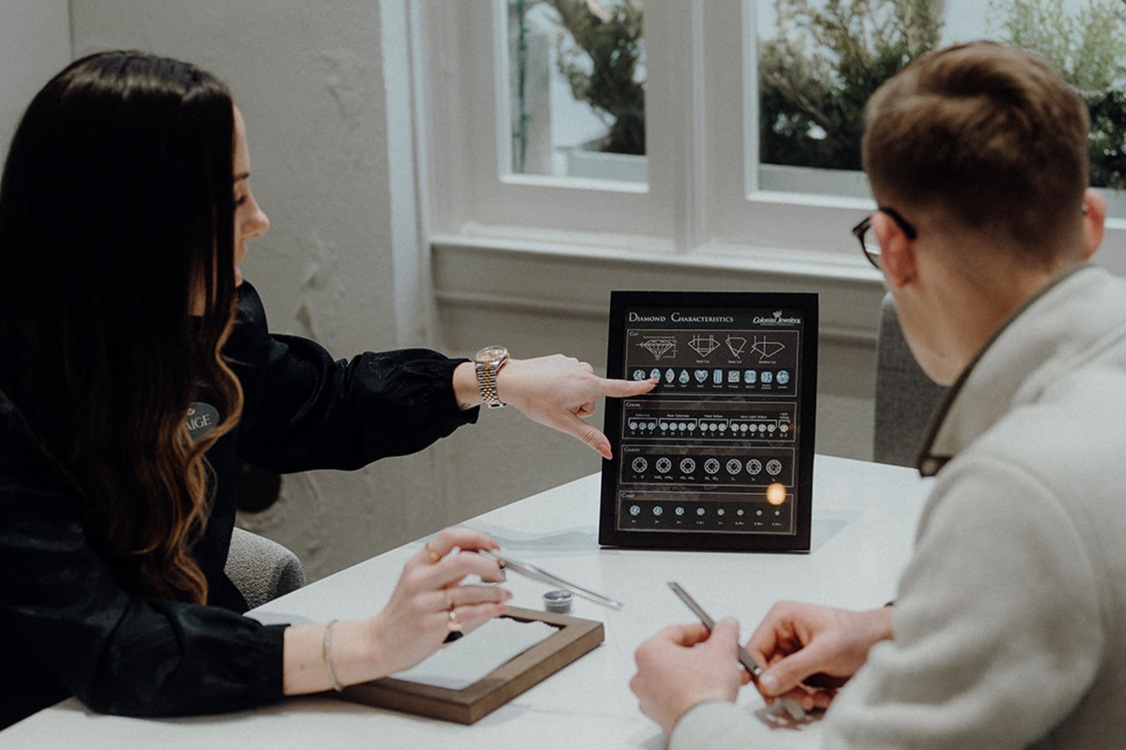Shopping for a diamond, whether for an engagement ring, anniversary gift, or personal milestone, is an exciting experience. However, with numerous options and technical terms to consider, it's easy to feel overwhelmed. That's why understanding the 4 C's of diamonds Cut, Clarity, Color, and Carat is essential before making your purchase. In this guide, we'll break down each of these key factors so you can shop with confidence and choose the perfect diamond for your style, budget, and occasion.
1. CUT
Before shopping for a diamond, you should familiarize yourself with the 4 C's: Cut, Clarity, Color, and Carat. Here at Colonial Jewelers we have a team of experts who will be happy to explain what all this means and how it will help you choose the best diamond within your budget whether you're purchasing from our engagement ring collection or designing a custom engagement ring.In the meantime, let's talk about Cut.
The cut is what fuels a diamond's fire, sparkle, and brilliance. The appeal and beauty of a diamond depend more on cut quality than anything else. The GIA Diamond Cut Grading System for standard round brilliants in the D-Z color range is based on assessing seven components. Learn more about different diamond shapes and why proportions matter when choosing your stone.
The first three are appearance-based aspects,
- Brightness: the total light reflected from the diamond
- Fire: the dispersion of light into the colors of the spectrum
- Scintillation: the pattern of light and dark areas and the flashes of light, or sparkle, when a diamond is moved
Some would argue that this is not the place to try to save money when looking to purchase a diamond. See how our gemologists hand-pick diamonds based on these optical characteristics.
The last four are related to the diamond's design and craftsmanship,
- Weight ratio
- Durability
- Polish
- Symmetry
In GIA's system, each of these factors is assessed individually. Each cut grade, based on a relative scale from Excellent to Poor, represents a range of proportion sets and face-up appearance. Many different proportion sets produce attractive diamonds. For more insight, check out our full engagement ring shopping FAQs.
2. CLARITY
At Colonial Jewelers, we want to help you make the most informed decision when purchasing a diamond. Whether you're shopping for engagement rings, a tennis bracelet, or looking to upgrade, you should be familiar with the 4 C's. We've already talked Cut, now let's talk about Clarity.
Diamonds form deep within the earth under an incredible amount of heat and pressure. As a result, they often exhibit unique birthmarks, either internal (inclusions) or external (blemishes). Diamond clarity refers to the absence of inclusions and blemishes within a diamond. Diamonds found without these birthmarks are rare, which ultimately affects a diamond's value. Using the GIA International Diamond Grading System, all diamonds are assigned a grade. Clarity grade ranges from flawless (FL) to diamonds with noticeable inclusions (I3).
The GIA Clarity Scale contains 11 grades:
- Flawless (FL): No inclusions or blemishes
- Internally Flawless (IF): No inclusions, only blemishes
- Very, Very Slightly Included (VVS1, VVS2): Inclusions are difficult to see
- Very Slightly Included (VS1 AND VS2): Inclusions are minor and somewhat difficult to see
- Slightly Included (SI): Inclusions are noticeable
- Included (I1, I2, I3): Inclusions are obvious based on a skilled grader using a 10x magnification.
3. COLOR
The color of a diamond is all about what you can't see. The value of a diamond is determined by its colorlessness; the less color, the higher the value. The only exception to this is fancy color diamonds, such as pinks and blues. These colors lie outside of the traditional grading scale.
GIA (Gemological Institute of America) set the industry-standard color grading scale for diamonds, which goes from D (colorless), with increasing presence of color, to the letter Z (light yellow or brown). Each letter grade has a defined range of color appearance. To the untrained eye, the color variations are too subtle to notice. However, when shopping for a diamond, you should know these slight differences help to determine quality and price.
Looking for value and sustainability? Many shoppers are exploring lab-grown diamond rings as a beautiful and ethical alternative.
4. CARAT
Diamonds and other gemstones are weighed in metric carats, not to be confused with karat, which refers to gold purity. One carat is equal to 0.2 grams, just about the same weight as a paperclip. A carat is divided into 100 points; a 50-point diamond weighs 0.50 carats. Being precise is crucial because even a fraction of a carat can make a big difference in cost.
Diamonds of equal weight can have different values depending on the other three C's: clarity, cut, and color. For more insight into designing your dream ring, explore our custom engagement ring process.
Next Steps: See the Difference in Person
Want a deeper breakdown of all 4 C's? Don't miss our full guide to diamond shopping. Still have questions or want to compare diamonds in person? Our expert gemologists at Colonial Jewelers are here to walk you through every detail. Book an appointment or stop by our Downtown Frederick, MD showroom to explore our hand-selected diamond collection and find the perfect stone for your special moment.
